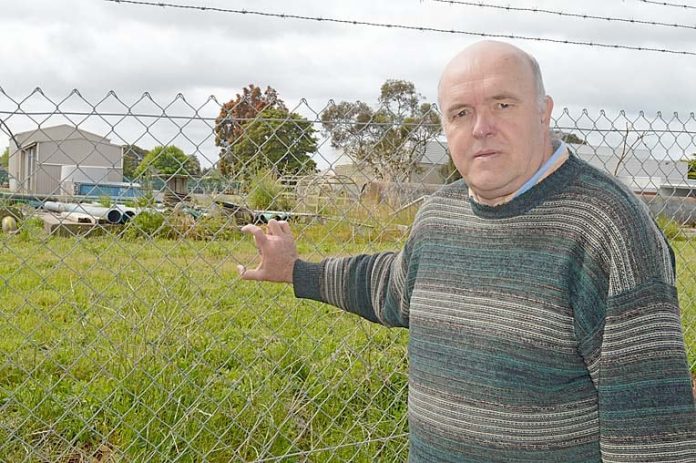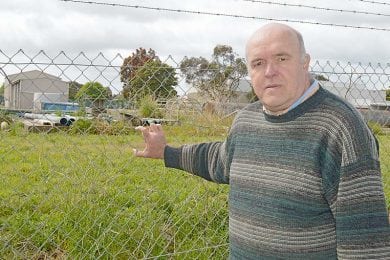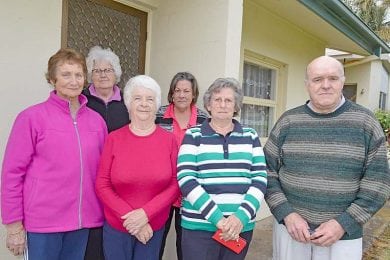

Picture: LEON RADEMEYER
A CONTAMINATION scare has gripped a Mount Gambier neighbourhood after it was revealed an SA Water depot is storing “asbestos containing materials” in a residential area.
Fearing for their wellbeing and the negative economic impact it could have on property values, residents of Cunningham Street neighbouring SA Water’s Commercial Street West depot have pulled together to protest.
“The dirty little secret has been exposed,” property owner Kevin Hughes told The Border Watch.
“SA Water has been storing materials containing asbestos right on our doorstep with only a boundary fence separating my property from the depot.
“These materials include pipes that were removed during their repair operations around the city.
“Why store it in the middle of a residential area and not out of town?
“We are all at risk here and you can forget about selling your house at a competitive price with the depot right next to your boundary fence.”
Mr Hughes said residents had now received a letter from the Environmental Protection Authority seeking feedback regarding granting SA Water an environmental licence to conduct waste recycling at its 288-292 Commercial Street West depot.
The licence would “enable the lawful storage of asbestos containing materials arising from SA Water’s operations prior to disposal at EPA licensed landfills”.
Residents can respond anonymously until end of business on Friday, after which SA Water will be given an opportunity for feedback before a decision is made by the EPA.
“Does this mean SA Water has been storing these materials illegally since they do not have a licence?” Mr Hughes asked.
“We heard the plan will only cover the material in double plastic wrap and then store it in bins.
“Surely that is a very unsafe way of doing it?”
Mr Hughes’ words were echoed by long-time resident Gillian Jacobson, who said she and many other residents had been living in the area for around 50 years.
“We love this quiet little street and many of us were here when it was made all those years ago,” she said.
“We are very upset to think asbestos contaminating materials are stored here and could continue to be stored here in future.
“On windy days we are covered by a dust cloud coming from the depot without having an idea what that dust might contain.”
SA Water conceded there had been a misunderstanding regarding the need for a licence to temporarily store materials containing asbestos.
Customer field services senior manger Colin Bell said SA Water believed its practices did not require the specific EPA licence in question.
“As materials containing asbestos are generated from our network and are temporarily stored at our own sites prior to disposal, we believed this constituted temporary storage of asbestos material at the place at which it was produced and hence no licence was required,” Mr Bell said.
“However, the EPA has confirmed our existing practices do not represent a risk to workers, the public or the environment.
“We are not undertaking any asbestos processing and our practices are in accordance with the Australian Code of Practice for Managing Asbestos Containing Materials and relevant work health safety regulations.
“Recent licence notifications made by the EPA are simply to formalise our long-held safe practices.”
He said SA Water had applied to the EPA for five licence applications – one per SA Water operational region – to temporarily store small quantities of non-friable asbestos at 31 of its sites across the state, including in Mount Gambier.
“In this instance, it refers to asbestos cement pipes that have been removed from our network when undertaking repairs,” Mr Bell said.
“The material is double-wrapped and temporarily held in designated storage bins on secure sites away from public access.
“Temporarily holding the pipes at our sites means they are kept safe until they can be permanently disposed of at a licensed facility.”
Mr Bell said SA Water has a licence to remove Class B asbestos (non-friable) and staff who work with this material are specially trained to ensure their safety and that of the wider community.
“Following clarification from the EPA, we have now applied for the relevant licence,” he said.










